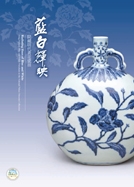Category
Radiating Hues of Blue and White: Ming Dynasty Blue-and-White Porcelains in the National Palace Museum Collection

- Published by Taiwan National Palace Museum
- Chief Editor: Tsai Mei-Fen, Weng Yu-Wen
- Language: Chinese and English
- ISBN: 978-957-562-747-8
- Hardcover: HK$600
Exchanges and interactions give culture new vitality. When arts created by different Asian civilizations are introduced to each other, they fascinate, inspire, and facilitate reproduction. The arts continue to develop and evolve into a unique art category of their own. Of such arts, the blue and white porcelains are among the most memorable. Their pure and bright appearances and delicate and exquisite decorations (produced using cobalt materials) are synonymous with porcelains of extreme beauty.
Radiating Hues of Blue and White: Ming Dynasty Blue-and-White Porcelains in the National Palace Museum Collection, one of the opening exhibitions of the National Palace Museum (NPM) Southern Branch, introduces the NPM’s rich collection of high-quality Ming dynasty blue and white porcelains. The said porcelains, which feature radiating hues of blue and white, are considered a masterpiece of Ming dynasty (1368–1644) craftsmanship. Through trades, bestowments, and gifting, blue and white porcelains became treasured artifacts for numerous Asian dynasties, influencing countries such as Korea, Vietnam, and Turkey. By making their own blue and white porcelains, the beauty of the “blue flowers” was introduced to everyday aesthetics. As these art pieces continued to circulate and inspire over time, they became a classic artifact in Asia.
This catalogue, edited by research fellow Tsai Mei-fen (of the Department of Antiquities, the NPM) and research assistant Weng Yu-wen (of the Department of the Southern Branch Museum Affairs, the NPM), contains a fascinating introduction to the exhibition items as well as detailed monographs of the historical background of blue and white porcelains in various Asian countries during the Ming dynasty. The magnificence of and differences between the blue and white porcelains produced by the different regions were analyzed using factors such as geographical origin, raw materials, and firing techniques. In addition, the evolution of the blue and white porcelains from a Chinese artifact to one used in Asia and Europe was explained. The blue and white porcelains, which are elegant, exquisite, gorgeous, and luxurious and feature constantly changing designs, continue to capture the fascination of people from all ethnicities. The radiating hues of blue and white have stood the test of time for more than 700 years and continue to amaze the world even this day.